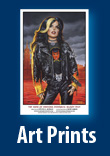In last Friday’s post, I told you a Tale of Development Hell involving a proposed collection of brand-new movie reviews that was canceled shortly after a number of writers and I had delivered our contributions. Here then, for your reading pleasure, is my never-before-published, tongue-in-cheek review of Horror Express, starring Christopher Lee, Peter Cushing, and Telly Savalas…
Your Nonstop Ride to Hell: Horror Express (1973)
Review by Steven A. Roman
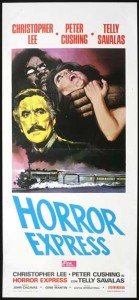 It’s not exactly the first thing that comes to mind when you think of those classic Christopher Lee/Peter Cushing cinematic pairings of yesteryear; probably not even the second or third (or eighth). Usually it’s one of the Hammer Studios’ Dracula series, or The Curse of Frankenstein, or The Mummy. But for all the memorable Dracula/Van Helsing clashes they had, for all the scientist-screwing-with-the-forces-of-nature roles they swapped, not even Lee and Cushing could have properly prepared themselves for the challenge handed them by director Eugenio Martín in his monster-on-a-train masterpiece Horror Express: matching wits with an evil psychic monkeyman—from outer space!
It’s not exactly the first thing that comes to mind when you think of those classic Christopher Lee/Peter Cushing cinematic pairings of yesteryear; probably not even the second or third (or eighth). Usually it’s one of the Hammer Studios’ Dracula series, or The Curse of Frankenstein, or The Mummy. But for all the memorable Dracula/Van Helsing clashes they had, for all the scientist-screwing-with-the-forces-of-nature roles they swapped, not even Lee and Cushing could have properly prepared themselves for the challenge handed them by director Eugenio Martín in his monster-on-a-train masterpiece Horror Express: matching wits with an evil psychic monkeyman—from outer space!
No, really.
In brief: It’s 1906, and Professor Alexander Saxton (Lee) is traveling from Shanghai to Moscow via Trans-Siberian Express, on his way back to England to show off his latest discovery: a two-million-year-old fossilized man-ape from a Szechuan Province cave. Things get off to a bad start, however, when a Chinese lockpick named Krasinky(!) tries to get a look at the find before it’s loaded on the train, and winds up dead for his troubles. From there, of course, the trip across the frozen Russian steppes progressively worsens as the “fossil” decides to get up and go on a killing spree, people bleed from the eyes while getting their brains erased (no, not just the audience), the creature takes over another character’s body, and Lee and Cushing trade quips as they try to figure out what the hell’s going on. And then Telly Savalas shows up to chew some scenery. Playing a Cossack.
No, really.
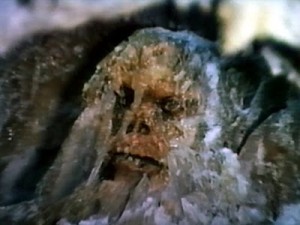 But Horror Express is more than just a tale of a moveable feast for the monster set that details how the brain of TV’s Kojak ultimately becomes a light snack for the unnamed creature. For a 90-minute fright flick, it packs a surprising amount of intellectualism into its running time, weaving a Murder on the Orient Express–style setting with a rampaging monster storyline that touches on such philosophical issues as: evolution; morality; science vs. religion; class structure; and the eternal battle between Good and Evil, as espoused ad infinitum by mad monk Father Pujardov (Alberto de Mendoza), who looks like a bearded Robert DeNiro dressed as Rasputin. Pretty heady stuff for an early seventies creature feature. It crosses over genres as well, going from horror to science fiction to drawing-room version of John Carpenter’s The Thing (during an attempt to locate the creature’s new host), then tosses in a bit of the ole zombie apocalypse on a runaway train just to round things off. And over it all can be heard the strange, whistle-and-guitar main theme by John Cacavas that would seem more at home in a Sergio Leone Western than a Euro body-count flick—a tune even the creature whistles at one point!
But Horror Express is more than just a tale of a moveable feast for the monster set that details how the brain of TV’s Kojak ultimately becomes a light snack for the unnamed creature. For a 90-minute fright flick, it packs a surprising amount of intellectualism into its running time, weaving a Murder on the Orient Express–style setting with a rampaging monster storyline that touches on such philosophical issues as: evolution; morality; science vs. religion; class structure; and the eternal battle between Good and Evil, as espoused ad infinitum by mad monk Father Pujardov (Alberto de Mendoza), who looks like a bearded Robert DeNiro dressed as Rasputin. Pretty heady stuff for an early seventies creature feature. It crosses over genres as well, going from horror to science fiction to drawing-room version of John Carpenter’s The Thing (during an attempt to locate the creature’s new host), then tosses in a bit of the ole zombie apocalypse on a runaway train just to round things off. And over it all can be heard the strange, whistle-and-guitar main theme by John Cacavas that would seem more at home in a Sergio Leone Western than a Euro body-count flick—a tune even the creature whistles at one point!
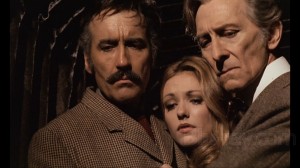 It’s not a redux of the theme from The Good, the Bad, and the Ugly you’re there for, though—you’re here for its star power! Lee and Cushing are in top form for this team-up, which followed their appearances the year before in director Freddie Francis’s The Creeping Flesh; their next reunion would be in 1974’s The Satanic Rites of Dracula (not exactly one of the finer entries in the series, unless you start comparing it to Dracula AD 1972). There’s an ease to their performances here, a relaxed interplay no doubt born of their numerous onscreen collaborations as well as their longstanding off-screen friendship. And though their roles as gentlemen scientists aren’t much different from other pre– and post–Victorian Era characters they played both before and after Horror Express, there’s still a freshness to their monster-hunting camaraderie. Like Bob Hope and Bing Crosby in a blood-spattered Road picture, Lee plays straight man to Cushing’s lighthearted ladies’ man, keeping a stiff upper scientific lip as his colleague lobs the occasional bon mot his way, as when they discover Saxton’s frozen monkeyman is up and around:
It’s not a redux of the theme from The Good, the Bad, and the Ugly you’re there for, though—you’re here for its star power! Lee and Cushing are in top form for this team-up, which followed their appearances the year before in director Freddie Francis’s The Creeping Flesh; their next reunion would be in 1974’s The Satanic Rites of Dracula (not exactly one of the finer entries in the series, unless you start comparing it to Dracula AD 1972). There’s an ease to their performances here, a relaxed interplay no doubt born of their numerous onscreen collaborations as well as their longstanding off-screen friendship. And though their roles as gentlemen scientists aren’t much different from other pre– and post–Victorian Era characters they played both before and after Horror Express, there’s still a freshness to their monster-hunting camaraderie. Like Bob Hope and Bing Crosby in a blood-spattered Road picture, Lee plays straight man to Cushing’s lighthearted ladies’ man, keeping a stiff upper scientific lip as his colleague lobs the occasional bon mot his way, as when they discover Saxton’s frozen monkeyman is up and around:
“Are you telling me that an ape that lived two million years ago got out of that crate, killed the baggage man and put him in there, then locked everything up neat and tidy, and got away?”
That Peter Cushing. Always willing to help a late-arriving moviegoer with a handy recap. You half expect him to turn to the camera and say, “Now do try to keep up, won’t you?” And given the energy with which Cushing throws himself into the role of Dr. Wells—bribing a Shanghai station master for a berth on the train, slyly admiring the Chinese silk-wrapped curves of a beautiful jewel thief (Helga Liné) who’s talked her way into his sleeping quarters (which he has to share with stuffy old Prof. Saxton, unfortunately)—it’s astonishing to learn he was in the midst of grieving for his wife, Violet Helene Beck, who died shortly before filming started. It’s a testament to Cushing’s abilities as an actor that he was able to keep the undoubtedly crushing weight of this personal tragedy off his shoulders long enough to get through the production, considering how often he admitted—right up to his own death in 1994—that he never recovered from Helene’s passing.
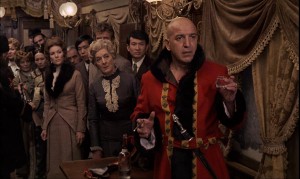 As for Telly Savalas’s welcome appearance as Captain Kazan—welcome in that his arrival livens things up just as the story is really starting to drag (Stop with all the talking! Where’s the wholesale slaughter?!)—well, it probably had to do with the fact he and Martín had worked together just a year before. As the star of Martín’s 1972 in-name-only biopic Pancho Villa, the Greek-American Savalas not only provided a unique interpretation of the Mexican revolutionary, but even sang the catchy tune “We All End Up the Same” over the closing credits. Thankfully, if only because of the brevity of his screen time, we’re spared hearing Telly’s dulcet tones in Horror Express; one monster making people’s eyes bleed is more than enough.
As for Telly Savalas’s welcome appearance as Captain Kazan—welcome in that his arrival livens things up just as the story is really starting to drag (Stop with all the talking! Where’s the wholesale slaughter?!)—well, it probably had to do with the fact he and Martín had worked together just a year before. As the star of Martín’s 1972 in-name-only biopic Pancho Villa, the Greek-American Savalas not only provided a unique interpretation of the Mexican revolutionary, but even sang the catchy tune “We All End Up the Same” over the closing credits. Thankfully, if only because of the brevity of his screen time, we’re spared hearing Telly’s dulcet tones in Horror Express; one monster making people’s eyes bleed is more than enough.
In terms of US box office appeal, however, a little Telly possibly went a long way back in ’73 (he did get third billing, after all). Given the immense popularity of his starring role as television detective Kojak—the series having premiered a few months before Horror Express pulled into theatres in January 1974—it’s entirely plausible that Stateside fans filed into their local movie theatres to check out the latest doings of their favorite TV cop. But if they were expecting a Tootsie Pop–sucking, ‘Who loves ya, baby?’ kind of policeman who’d pop a cap in monkeyman’s ass, they were instead treated to the sight of a lecherous, ruthless Russian captain battling the undead.
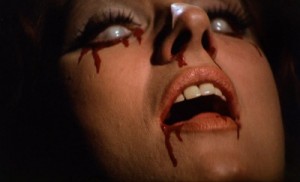
And speaking of the undead… The gore level, unfortunately, isn’t anywhere near what today’s audiences have grown accustomed to—and even clamored for, in this age of “body horror” films like Eli Roth’s Cabin Fever and Hostel, the Saw series, and pretty much everything by Japanese horrormeister Takashi Miike. The deteriorated creature (played by Juan Olaguivel) is a man in a shaggy suit, its apelike face rotted to the bone on one side—all the better to show off the glowing red eye that hypnotizes victims before their brains are sucked dry. Wisely, Martín keeps the lighting low and his monster in the shadows for most of its appearances, all the better to convince us that this thing actually poses a threat to the cast. The majority of makeup effects, however, simply involve blood rimming the bottom edges of the victims’ eyes, and a well-bitten gelatin capsule to get that fresh-from-the-lungs sanguinary touch around their mouths. Add a few sets of white opaque contact lenses to simulate the blank, fish-eyed gaze of the deceased, and that’s about as hardcore as the creature’s handiwork gets. And the one autopsy scene, in which Cushing tries to determine the cause of death of the baggage handler by opening up his skull with a hacksaw, is more amusing than gruesome. Especially when he discovers the altering effect of the monster’s psychic mind-drain on the man’s normally wrinkled brain. “Smooth as a baby’s bottom!” his assistant Miss Jones (Alice Reinhart) succinctly puts it.
Clive Barker’s cannibal-themed “Midnight Meat Train” this ain’t.
That’s not to say the movie doesn’t have an uncomfortable moment or two, but they generally come from a scene involving the dissection of one of the creature’s eyes, and modern gorehounds may find it more laughable than squirm inducing. As it turns out, though, stabbing a needle in the monster’s eye—three times, in fact—isn’t merely done for shock value; it’s a method by which to advance the plot, because the creature’s cornea is filled, not so much with blood, but with history.
Seriously.
Integrating the old wives’ tale that the eyes of a dead person actually retain the last image they recorded, screenwriters Arnaud d’Usseau and Julian Zimet have Lee discover that if you poke the monster’s eyeball and put a drop of its blood under a microscope, you can actually see the creature’s two-million-year-old memories! Or at least an artist’s rendering of those memories, since the brontosaurus and pterodactyl that appear on the glass slides are obvious line drawings with “blood” sloshed in front of the camera lens to obscure them a bit.
Those crafty writers. Even their gross-out “injury to the eye” scene has an intellectual angle to it!
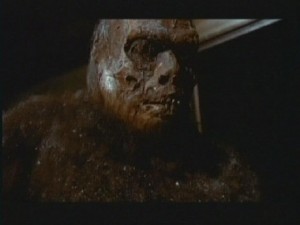
Still, highfalutin thinking aside, the question remains: Just how well does Horror Express—a film that stylistically has more in common with Italian giallo thrillers than American shockers of the time (1973’s The Exorcist, 1972’s The Last House on the Left)—hold up, more than thirty years later? Well, it really depends on one’s tastes. Fans of kinetic, MTV-edited fare like Final Destination or Resident Evil may quickly lose patience with the film’s deliberate pace and highbrow discussions, and start wondering if they picked up a Merchant-Ivory period piece by mistake. Gorehounds will probably be disappointed by the lack of organs decorating the walls. But for fans of classic horror interested in seeing the interplay between two of the genre’s greatest actors in their prime, in a movie that doesn’t require that one of them dresses as Dracula and the other as Van Helsing, then Horror Express is definitely worth checking out. And with all the scenes in which characters debate mankind’s ongoing hunger for knowledge—which neatly parallels the monster’s brain-sucking—maybe you’ll even come out of it a little wiser.
No, really.
“Your Nonstop Ride to Hell: Horror Express” copyright © 2006 Steven A. Roman. All rights reserved.


